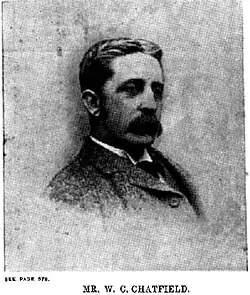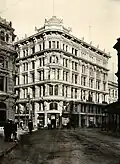William Chatfield
William Chatfield | |
|---|---|
 William Chatfield | |
| Born | 1851 Sussex, United Kingdom |
| Died | 30 May 1930 Wellington, New Zealand |
| Occupation | Architect |
| Buildings | Star Boating Club and Stewart Dawson's Building |
William Charles Chatfield (1851 – 30 May 1930) was a New Zealand architect. He was born in Sussex and educated in Brixton, Surrey.[1] He moved to New Zealand at the age of 16. In 1886 he designed the Wellington Opera House, which burnt down 2 years later.[2][3] Two of his remaining buildings are the Star Boating Club and the Stewart Dawson's Building.[4]
Chatfield died on 30 May 1930 aged 79.[5]
Early life

William Charles Chatfield was born at Greatham Manor in Parham Park, Sussex in 1851. Chatfield's father as a magistrate and his mother was a prominent artist. Chatfield received his education in Brixton, where he likely received his architectural education,[a] and immigrated to New Zealand in 1867.[b][6]
Architectural career
Chatfield's obituary stated he worked in the Public Works Department as a draughtsman from 1872 to 1876 but Chatfield was instead employed by the Wellington Provincial Government during this time.[c] Chatfield was made redundant in 1876 and went into private practice.[6] Prior to his employment with the provincial government Chatfield had a private practice according to his obituary, although no tenders in his name exist prior to 1872.[7]
In private practice Chatfield mostly designed commercial buildings around Wellington's central business district although Chatfield did design some residential buildings in Wellington. Approximately 260 designs have been attributed to Chatfield from 1875 to 1927. Chatfield employed High Victorian plaster designs into his buildings with a notable example being the Stewart Dawson's Building. Chatfield used recycled railway irons to strengthen his designs.[6] Most of Chatfield's work was demolished in the 1970s and 1980s.[8]
In 1892 Chatfield and Frank Jacobsen were selected to make alterations to parliament's ventilation system. The Hawkes Bay Herald accused the government of selecting the two men over government architects due to their political leanings. The controversy did not impact Chatfield's career.[6]
In 1894 Chatfield became president of the Wellington Association of Architects. Chatfield later became founding president of the New Zealand Institute of Architects and was a made a life member in 1928.[6]
Personal life
Chatfield married Mary Hoggard in 1874. After her death he married Mary Tuckey in 1897.[6] The marriage took place at St Paul's Cathedral, Wellington and was well attended by Wellington's elite, with newspapers devoting significant page-length to the event.[9] Tuckey left Chatfield in 1913.[6]
From 1887 Chatfield lived in a villa at Island Bay that he designed and named Hurston. Chatfield was also a carpenter and designed his own furniture.[6]
List of works
| Name | Date | Image | Note | Ref |
|---|---|---|---|---|
| Bishop's Court | 1879 | Registered as a category 2 building with Heritage New Zealand | [10] | |
| Star Boating Club Building | 1886 |  |
Registered as a category 1 building with Heritage New Zealand | [11] |
| Wellington Opera House | 1886 | Burnt down in 1888 | [12][13] | |
| Hurston | 1887 | Registered as a category 2 building with Heritage New Zealand | [6][12] | |
| Colonial Mutual Life Assurance Building | 1897 |  |
[12] | |
| Stewart Dawson's Building | 1900 | Registered as a category 2 building with Heritage New Zealand | [14] | |
| Kings Chambers | 1902 |  |
Demolished circa 1968 | [12][15] |
| Kodak Building | 1908 | Demolished 1978 | [8] | |
| GHB Wilkinson Building | 1908 | .jpg) |
Registered as a category 2 building with Heritage New Zealand | [16] |
Further reading
- Mew, G.; Humphris, Adrian (2020). Architects at the Apex. ISBN 978-0-9941349-4-3.
Notes
- ^ Chatfield is said to have set up practice in 1867 suggesting he had studied architecture in England.[6]
- ^ A 'Chatfield' with no forename is recorded as arriving aboard the Wild Duck on 20 December 1867.[6]
- ^ This is confirmed by the Appendices to the Journal of the House of Representatives which lists Chatfield's redundancy in 1877.[6]
References
- ^ "Architects, Civil Engineers, Etc. — Including—Architects, Civil and Mining Engineers, Draughtsmen, Surveyors, Etc | NZETC". nzetc.victoria.ac.nz. Retrieved 21 June 2017.
- ^ "The Pioneer Prince | NZETC". nzetc.victoria.ac.nz. Retrieved 23 June 2017.
- ^ "Just Manners … – Architectural Centre – Wellington, New Zealand, architecture, design". Retrieved 23 June 2017.
- ^ "Search the List | Star Boating Club Building | Heritage New Zealand". www.heritage.org.nz. Retrieved 22 June 2017.
- ^ "Obituary". Otago Daily Times. No. 21040. 31 May 1930. p. 13. Retrieved 26 August 2017.
- ^ a b c d e f g h i j k l Mew, G.; Humphris, Adrian (October 2014). Raupo to Deco. p. 69–71. ISBN 978-1-927242-56-8.
- ^ Humphris, Adrian; Mew, Geoff (30 October 2010). "A Rose between Two Thorns; Tringham, Chatfield and Toxward, 1865 to 1870". Architectural History Aotearoa. 7: 20–21. doi:10.26686/aha.v7i.6787. ISSN 2703-6626.
- ^ a b Humphris, Adrian; Mew, Geoff (17 August 2022). "Fearsome Horses: the nightmares that wrecked Lambton Quay". Architectural History Aotearoa. 13: 39–45. doi:10.26686/aha.v13i.7784. ISSN 2703-6626.
- ^ Humphris, Adrian; Mew, Geoff (31 October 2007). "Carpenter, Artisan, Architect; Status In Late Nineteenth Century Wellington". Architectural History Aotearoa. 4: 28–33. doi:10.26686/aha.v4i0.6737. ISSN 2703-6626.
- ^ Sarich, Jonathan; Wallace, Paulette; Bargas, Imelda; Dangerfield, Alison (22 June 2007). Bishop's Court (Report). Heritage New Zealand.
- ^ Searle, Chloe; Dangerfield, Alison (21 April 2009). Star Boating Club Building (Report). Heritage New Zealand.
- ^ a b c d Williamson, Miranda (15 February 2021). Hurston (Report). Heritage New Zealand.
- ^ "The Opera House". Wellington City Heritage.
- ^ O'Brien, Rebecca (11 December 2003). Stewart Dawson's Building (Report). Heritage New Zealand.
- ^ "The Kings Chambers". Wellington City Library.
- ^ "Commercial Building". Wellington City Heritage.